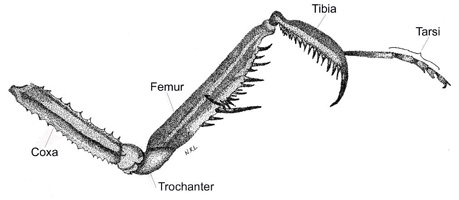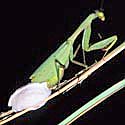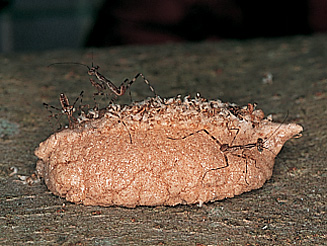|
Biology of Mantodea
Life >
Eukaryotes >
Opisthokonta >
Metazoa (animals) > Bilateria > Ecdysozoa > Panarthropoda > Tritocerebra >
Arthopoda > Mandibulata > Atelocerata > Panhexapoda >
Hexapoda
> Insecta
(insects) >
Dictyoptera
> Mantodea (mantids)
Body structure
Their head is triangular and extraordinarily mobile with large
compound eyes set very high on the upper corners and three simple eyes called ocelli on top of the head (between the compound eyes). Females
are normally unwinged with the males being winged in order to fly in search of
females. Mantids have long spiny front legs which enable them to aptly
capture live prey.
|
 |
|
Preying Mantis leg. [drawing by Nicole
Larsen, © used with permission.] |
Courtship and mating
Female mantids are notorious for making a meal of their mates. As her
suitor perches on her back, devotedly doing his duty, she will usually
look round and casually start chewing his head off. Numerous
publications seem to find this snippet of information incorrect.
Unfortunately, we do not really know what happens. Death by
cephalic self-sacrifice certainly seems to be the occasional fate
befalling mating male mantids. This probably occurs when something
goes wrong or disrupts the mating process. It is in the male
mantid's best interest to sire as many offspring as possible so rank
promiscuity with as many females as possible is a highly desirable
objective. Losing his head to his first mate will not help spread
the genes around and the male mantid is equipped with a set of tactics
that help him increase his chances of continued survival during intimate
contact with a female.
Male mantids are shorter and a lot
slimmer than the females, who sometimes look so different that one
is inclined to think they are a different species. This very
possibly puts the males at risk of being bullied with eventual
decapitation by their larger partners. However, during mating, the
head of the male is placed far back on the female so that the phrase
"out of sight, out of mind" might just be the most important factor for
his survival.
The pheremone of the female is so strong that it attracts
a large number of males who then have to fight to gain their prize.
When confronted with one another for the first time, the male and female
mantid fix one another with the typical mantid icy gaze. The male
then carefully and slowly "stalks" the female, this procedure being
carried out for an hour or two. Half-way through this, he launches
into an abdomen-waving sequence then suddenly leaps onto the female's
back (or into her arms if he misjudges). Once he is in position he
bends his abdomen in a motion that is akin to stroking, searching
contact with the females genital area. Finally, he twists his abdomen to
one side and the copulatory position is established. All this
effort does not go wasted, the female responds with pumping movements of
her abdomen and she may raise her fully extended forelegs in the air or
she may approach the male and stroke his front legs. She thus
seems to be an active and obliging participant in the whole mating drama
so the alluring prospect of recasting the partner's part from mate to
meal does not seem to figure. Mating can also be done successfully
without this sequence but success seems to be much higher when the
female becomes actively involved.
Egg laying and development
A female mantid, after a single act of mating, can lay more than one batch of
eggs with sufficient stored sperm. The smallest single egg-batch
known is around ten while some of the larger mantids can lay 400 eggs at
a single sitting. Some female mantids lay their eggs in soil while
the majority attach them to some object, sometimes in conspicuous
places. The eggs are not just dumped in any old fashion but carefully
placed inside a weather-proof protective enclosure, this structure being
called an ootheca. The ootheca is an amazing frothy structure in which
cells are made and the eggs are then deposited into these cells. When
the female has completed her egg laying, the froth hardens and cocoons
the eggs to help protect them from enemies and the drying effects of the
sun. After completing the lengthy process, the female may spend a
few minutes grooming the tip of her abdomen. It is important that
she does this as some froth may remain which would harden and
contaminate the body if not removed immediately.
After about a month, tiny nymphs start emerging from the ootheca via the
net-work of exit holes situated on the upper midline. Upon
emerging from their cell in the ootheca, each nymph is encased in a
membrane. When half-way out of the cell, the nymph pauses, waiting
for the pressure of blood pumped into its head to split open the
membrane, enabling the nymph to then shrug off the membrane. The nymphs
usually assemble on the ootheca, do one or two moults and start
resembling their parents. In some species the nymphs dangle
from a line of silken thread, moult and then drop to the ground and
disperse. One noticeable aspect of a nymph is that it carries its abdomen curled upwards over its back in a semi-circle, a strange
posture for which there is no explanation.
 |
 |
|
Frothy ootheca being laid. This hardens and
turns a biscuit colour. |
Ootheca
from which nymphs have emerged.
|
Prey and prey capture
Mantids are diurnal
(day active) and have fierce predatory habits. They are well equipped to
carry out their deadly ambush in that their front legs are liberally furnished
with rows of spines. The spines on the femur are slightly tilted in one
direction, those on the tibia in another direction so that when the two sections
are snapped shut the prey is spiked on a kind of mobile gin-trap - no escape.
The long spines on the outermost part of the tibia also act as grappling hooks
as they are slung outwards over the prey's body. It is rare that anything
escapes a mantids grasp. If suitably sized prey comes into view, the mantid
slowly turns its head to view the prey and weigh up the possibilities. As
soon as the mantid has judged the distance to the prey, the front legs are thrust
forwards, moving as fast as lightening. The whole capture is performed
with extreme precision and it is rare that prey escapes the grasp. A mantid can
strike in whichever direction its head is pointing. They are not fussy
eaters and will happily munch away at anything that comes their way, even insects
that share their predatory habits, such as assassin bugs and wasps.
When a mantid begins a meal, it starts with the head or neck, thus cutting
out any means of struggle from its victim. This may be an important
factor, especially when the prey is bigger than the mantid itself. Guillotining
the head also makes way for the juicier parts - the nourishing tissues that are
packed inside the thorax. Mantids are thrifty eaters and normally manage
even the tough legs and head parts, their jaws chewing away from side to side,
processing the food into tiny morsels that will pass down through their rather
narrow gullets. A mantids menu consists of moths, butterflies, grasshoppers,
flies, beetles,
caterpillars and even spiders. They will also eat other mantids which makes that
seem a little bit cannibalistic but when you are hungry and food is scarce,
well.....
Where they live
Mantids enjoy a wide distribution all around the world
except in regions that are permanently cold and they can be found in virtually
any kind of habitat, from the wind-swept seashore to the humid green forests,
from parched hot deserts to chilly mountainsides. Each genus and species is
adapted to the ecological factors of tits residence. In other words, a mantid
that dwells in desert regions would not thrive and succeed if taken from there
and put into a forestry region or vice versa. Children often ask if they
are able to keep a praying mantis as a pet. Yes, you probably could but take
into consideration that mantids wander. A large cage made out of small mesh
wire and a few plants should suffice. And, of course, you have to remember
to catch prey for them otherwise they, in all likelihood, will not survive.
This works by trial and error, one might be successful and then one might not.
Perhaps it is better to leave them where they belong in nature and admire them from a
distance.
Page by Dawn Larsen |
